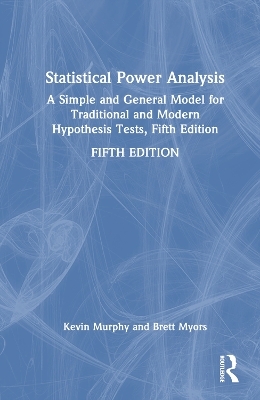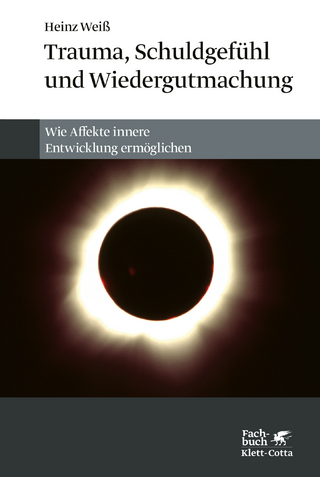
Statistical Power Analysis
Routledge (Verlag)
978-1-032-28301-2 (ISBN)
Statistical Power Analysis explains the key concepts in statistical power analysis and illustrates their application in both tests of traditional null hypotheses (that treatments or interventions have no effect in the population) and in tests of the minimum-effect hypotheses (that the population effects of treatments or interventions are so small that they can be safely treated as unimportant). It provides readers with the tools to understand and perform power analyses for virtually all the statistical methods used in the social and behavioral sciences.
Brett Myors and Kevin Murphy apply the latest approaches of power analysis to both null hypothesis and minimum-effect testing using the same basic unified model. This book starts with a review of the key concepts that underly statistical power. It goes on to show how to perform and interpret power analyses, and the ways to use them to diagnose and plan research. We discuss the uses of power analysis in correlation and regression, in the analysis of experimental data, and in multilevel studies. This edition includes new material and new power software. The programs used for power analysis in this book have been re-written in R, a language that is widely used and freely available. The authors include R codes for all programs, and we have also provided a web-based app that allows users who are not comfortable with R to perform a wide range of analyses using any computer or device that provides access to the web.
Statistical Power Analysis helps readers design studies, diagnose existing studies, and understand why hypothesis tests come out the way they do. The fifth edition includes updates to all chapters to accommodate the most current scholarship, as well as recalculations of all examples. This book is intended for graduate students and faculty in the behavioral and social sciences; researchers in other fields will find the concepts and methods laid out here valuable and applicable to studies in many domains.
Kevin Murphy is a professor emeritus, University of Limerick, and an Organizational Psychologist. He is an author and editor of over 13 books and over 200 articles and chapters, in areas ranging from data analysis and research design to performance appraisal and performance management Brett Myors received his PhD in Psychology from University of New South Wales, with a Postdoctoral appointment at Colorado State University. He served as director of organisational psychology at Griffith University and has published methodological research in several leading journals. He currently resides in the United Kingdom.
1. The Power of Statistical Tests 1.1 The Structure of Statistical Tests 1.1.1 Null Hypotheses vs. Nil Hypotheses1.1.2 Understanding Conditional Probability 1.2 The Mechanics of Power Analysis 1.2.1 Understanding Sampling 1.2.2 Distributions d vs. delta vs. g 1.3 Statistical Power of Research in the Social and Behavioral Sciences Power and the Replication Crisis 1.4 Using Power Analysis The Meaning of Statistical Significance 1.5 Hypothesis Tests vs. Confidence Intervals Accuracy in Parameter Estimation 1.6 What Can We Learn from a Null Hypothesis Test? 1.7 Summary 2. A Simple and General Model for Power Analysis 2.1 The General Linear Model, the F Statistic, and Effect Size 2.1.1 Effect Size 2.2 Understanding Linear Models 2.3 The F Distribution and Power 2.3.1 Confidence Intervals for PV and d 2.4 Using the Noncentral F Distribution to Assess Power 2.5 Translating Common Statistics and ES Measures into F 2.5.1 Worked Example – Hierarchical Regression 2.5.2 Worked Examples Using the d Statistic 2.6 Defining Large, Medium and Small Effects 2.7 Nonparametric and Robust Statistics 2.8 From F to Power Analysis 2.9 Analytic and Tabular Methods of Power Analysis 2.10 Using the One-Stop F Table 2.11 Simple and General Software for Power Analysis 2.12 R code for Power Analysis for Traditional and Modern Hypothesis Tests 2.13 Summary 3. Power Analyses for Minimum-Effect Tests 3.1 Nil Hypothesis Testing 3.2 The Nil Hypothesis is Almost Always Wrong 3.2.1 Polar Bear Traps: Why Type I Error Control is a Bad Investment 3.3 The Nil may not be True, but it is Often Fairly Accurate 3.4 Minimum-Effect tests as Alternatives to Traditional Null Hypothesis Tests 3.5 Sometimes a Point Hypothesis is also a Range Hypothesis 3.6 How do you Know the Effect Size? 3.7 Testing the Hypothesis that Treatment Effects are Negligible 3.8 Using the One-Stop Tables to Assess Power for Minimum-Effect Tests 3.9 A Worked Example of Minimum-Effect Testing 3.10 Type I Errors in Minimum-Effect Tests 3.11 Summary 4. Using Power Analyses 4.1 Estimating the Effect Size 4.2 Using the One-Stop Tables and the R Code/Shiny Web app to Perform Power Analyses 4.2.1 Worked Example: Calculating F-equivalents and Power 4.3 Four Applications of Statistical Power Analysis 4.4 Calculating Power 4.5 Determining Sample Sizes 4.6 A Few Simple Approximations for Determining Sample Size Needed 4.7 Determining the Sensitivity of Studies 4.8 Determining Appropriate Decision Criteria 4.8.1 Finding a Sensible Alpha 4.9 Post-Hoc Power Analysis Should be Avoided 4.10 Summary 5. Correlation and Regression 5.1 The Perils of Working with Large Samples 5.2 Multiple Regression 5.2.1 Testing Minimum-Effect Hypotheses in Multiple Regression 5.3 Power in Testing for Moderators 5.3.1 Power Analysis for Moderators 5.4 Implications of Low Power in Tests for Moderators 5.5 If You Understand Regression, You Will Understand (Almost) Everything 5.6 Summary 6. t-Tests and the One-Way Analysis of Variance 6.1 The t Test 6.2 The t distribution vs the Normal Distribution 6.3 Independent Groups t Test 6.3.1 Determining an Appropriate Sample Size 6.4 One- Versus Two Tailed Tests 6.4.1 Re-analysis of Smoking Reduction Treatments: One-Tailed Tests 6.5 Repeated Measures or Dependent t Test 6.6 The Analysis of Variance 6.6.1 Retrieving Effect Size Information from F Ratios 6.7 Which Means Differ? 6.8 Designing a One-way ANOVA Study 6.9 Summary 7. Multi-Factor ANOVA Designs 7.1 The Factorial Analysis of Variance 7.1.2 Calculating PV from F and df in Multi-Factor ANOVA: Worked Example 7.2 Factorial ANOVA from Means and Standard Deviations 7.2.1 Reconstructing ANOVA results from descriptive statistics: A Worked Example 7.2.2 Eta squared vs. partial eta squared 7.3 General Design Principles for Multifactor ANOVA 7.4 Fixed, Mixed and Random Models 7.5 Summary 8. Studies with Multiple Observations for Each Subject: Repeated-Measures and Multivariate Analyses 8.1 Randomized Block ANOVA: An Introduction to Repeated Measures Designs 8.2 Independent Groups versus Repeated Measures 8.3 Complexities in Estimating Power in Repeated-Measures Designs 8.4 Mixed Designs: Split Plot Factorial ANOVA 8.4.1 Estimating Power for a Split Plot Factorial ANOVA 8.5 Power for Within-Subject vs. Between-Subject Factors 8.6 Split-Plot Designs with Multiple Repeated-Measures Factors 8.7 The Multivariate Analysis of Variance 8.8 Summary 9. Power Analysis for Multilevel Studies 9.1 What do Multilevel Analyses Tell You? 9.2 The Multilevel Equation 9.3 Are Multilevel Models Necessary? – The Intraclass Correlation 9.4 An Illustration of Multilevel Analysis 9.5 Remember, It’s All Regression 9.6 Effect Sizes in Multilevel Analysis 9.6.1 R code for obtaining R2 and pseudo-R2 estimates 9.7 Power for What? 9.8 Using Changes in Model Fit as a Basis for Power Analysis in Multilevel Modeling 9.9 R code for calculating critical chi squared values and power for minimum-effect comparisons of models 9.10 Sample Size – Some General Guidance 9.11 Summary 10. The Implications of Power Analyses 10.1 Tests of the Traditional Null Hypothesis 10.2 Tests of Minimum-Effect Hypotheses 10.2.1 Type I Errors in Minimum-Effect Tests Revisited 10.2.2 Statistical Power and the Replication Crisis 10.3 Power Analysis: Benefits, Costs, and Implications for Hypothesis Testing 10.4 Direct Benefits of Power Analysis 10.4.1 Is HARKing a Serious Problem? 10.5 Indirect Benefits of Power Analysis 10.6 Costs Associated With Power Analysis 10.7 Implications of Power Analysis: Can Power be too High? 10.8 Summary 11. Appendix A – Translating Statistics into F and PV Values 12 Appendix B - One Stop F Table 13. Appendix C- One Stop PV Table 14. Appendix D – dferr Needed for Power of .80 for Nil and Minimum-Effect Hypothesis Tests
| Erscheinungsdatum | 13.02.2023 |
|---|---|
| Zusatzinfo | 12 Line drawings, black and white; 12 Illustrations, black and white |
| Verlagsort | London |
| Sprache | englisch |
| Maße | 152 x 229 mm |
| Gewicht | 571 g |
| Themenwelt | Geisteswissenschaften ► Psychologie ► Allgemeine Psychologie |
| Wirtschaft ► Betriebswirtschaft / Management | |
| Wirtschaft ► Volkswirtschaftslehre | |
| ISBN-10 | 1-032-28301-7 / 1032283017 |
| ISBN-13 | 978-1-032-28301-2 / 9781032283012 |
| Zustand | Neuware |
| Haben Sie eine Frage zum Produkt? |
aus dem Bereich


